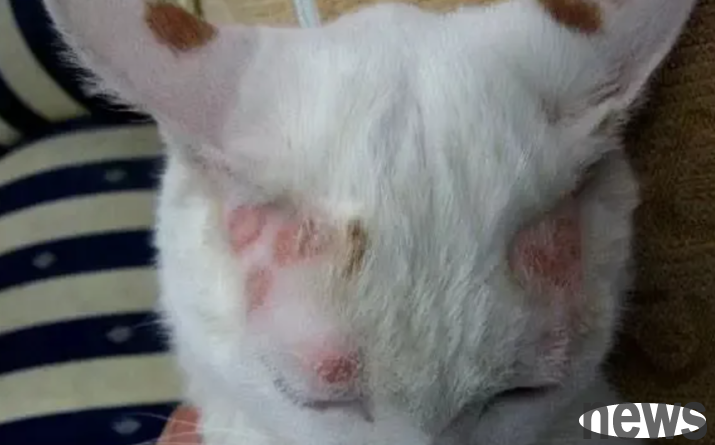1. Pathogenic mechanism of ringworm
Ringworm is a skin disease caused by fungal infection. It is more common in kittens and malnourished, frail and sickly adult cats.
The initial infection area will initially appear on the face, ears and forelimbs. If you think this is not a big deal at the beginning and don’t pay attention to treatment, it will eventually develop severely throughout the body.

Among them, 98% of cat ringworm are infected by Microsporidium canis, which are typically rounded hair removal spots, scabs on the edges of the spots, white dander loss, and the skin in the hair removal area is obviously red.
(So far, three fungi are found to infect cats, namely Microsporidium canis, Microsporidium gypsum, and Trichophyton sarcophagus.)
Not only that, sometimes ringworm can also show some special symptoms:
For example, papule dermatitis (like the skin bulge after being bitten by a mosquito) may occur on the back, and some cats also show large areas of hair loss, erythema, itching, scab, etc.
Special attention:
When humans' self-resistance decreases, including the elderly, pregnant women, and children, they will be infected with ringworm. The symptoms are initially red papules or small blisters, and then ring-shaped red scales are formed, with clear edges, continuous expansion, and accompanied by severe itching. Therefore, once it is discovered, it must be treated in time, and do not take it seriously.
2. How to detect ringworm
1. When you are at home, you will find that cats have local hair loss, white dander, and red skin, it may be ringworm.
However, it is impossible to diagnose the diagnosis by naked eyes. It is best to take it to the hospital for skin tests as soon as possible to confirm whether it is caused by microsporidium canis.
2. During the hospital examination,
● Microscopy: Through skin scraping and staining, we can see clearly spun conical macroconidia under the microscope, which is Microsporidium Canis.
● About 50% of the Wood's lamps, Microsporidium canis emit apple green fluorescence under the Wood's lamp.
● Fungal culture
White to yellow villous colonies can be seen through fungal culture.

3. Prevention and treatment of ringworm
1. Prevention
In fact, prevention is not that mysterious.
Why do cats get ringworm? Because of fungal infection, why are fungal infections? Because you don’t pay attention to hygiene!
Therefore, it is necessary to disinfect the home environment. Fungal spores are everywhere. Do a good job of disinfecting the home environment (it is best to use DuPont Weike disinfectant) to reduce the source of infection to prevent infection in cat ringworm.
At the same time, cats should also pay attention to nutritional matching in their daily diet to improve their resistance.
2. Treatment
● When the symptoms are mild, when the cat only has local symptoms and has confirmed the infection of Microsporidium canis through laboratory tests, it is recommended to use scissors to cut off a circle of hair around the affected area of the skin root.
Because fungal spores easily adhere to hair, cutting off hair can reduce fungal amplification.
If you are a multi-cat family, a long-haired cat or a cat with ringworm all over the body, hair cuts may be recommended throughout the body. However, we should consider whether to shave the whole body according to the severity of the condition.
After haircutting, use a cotton swab to apply the topical ointment containing ketoconazole on the sick skin, apply it to the affected area 3-5 times a day, and use it for at least 7 consecutive days. A significant improvement can be seen in mild symptoms.
● When the symptoms are severe, for more severe systemic ringworm, it is recommended to use an antifungal bath and wash the whole body twice a week.
After wet the whole body, apply the bath solution evenly on the whole body, stay for 10 to 15 minutes, and after the effect of the medicine is fully utilized, then wash off the foam on the cat's body with clean water. Be sure to dry it in time after each medicine bath.
At this time, you can't just apply topical medicine. Sometimes doctors also prescribe export medications for treatment: itraconazole, terbinafine, greyofomycin, etc.
However, these drugs are prescription drugs and have certain side effects. They must be used under the guidance of a doctor. If necessary, blood is required to be taken for a follow-up examination.
Cat Bureau reminds:
While treating ringworm in daily life, you should also pay attention to the intake of fatty acids. ω6 and ω3 play a good role in preventing and treating skin allergies, fur removal, shining hair, and brain intellectual development in cats. It can also help cat ringworm recover faster and promote the growth of hair on the affected area.
